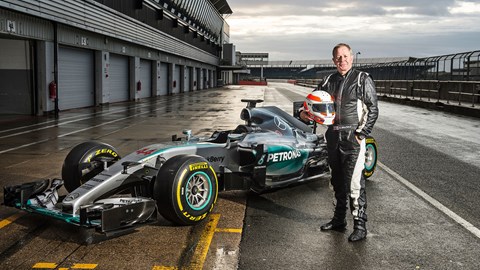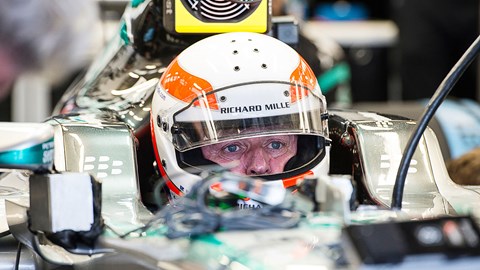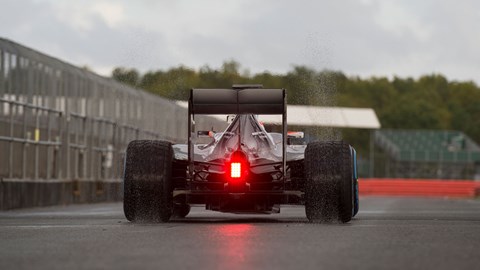► The W06 driven by Martin Brundle
► Took Lewis Hamilton to his third world title
► The most dominant car until…the W07
Think Usain Bolt and Mo Farah combined; for the Mercedes W06 – the car that swept Lewis Hamilton to his third World Championship with four races to spare – was able to replicate the talents of both. It was a hugely impressive sprinter during qualifying, while still able to dominate the long game on Sundays.
The car took 18 poles and 16 wins from 19 races and it hoovered up 85.3% of the available points, up from 81.5% last year. No car in the history of F1 had been more dominant; even McLaren’s MP4-4 of 1988 took ‘only’ 83% of the available points.
How a F1 hybrid engine works
Versatility was the key to the W06’s success: a 30bhp advantage over the opposition allowed it to dominate at the power tracks of Monza and Spa; superior levels of traction and mechanical grip won through at Monaco and Melbourne, and unrivalled aerodynamic efficiency gave the car an advantage at Silverstone and Barcelona. There was no weakness. Even Singapore, where it was mysteriously outclassed by Ferrari’s F15-T, would be a different story if we went back to Marina Bay right now.
‘I know I’m incredibly lucky to drive for a team like this,’ said Hamilton. ‘They’ve given me the best car; it’s just so much fun to drive and so fast. I feel blessed to have this opportunity.’
Mercedes brings F1 tech to the road
Much has been written about Hamilton’s prodigious talent, which many believe makes him capable of wringing great performances even from an uncompetitive car, but the astonishing late-season resurgence of Hamilton’s team-mate Nico Rosberg suggests something else is happening too. Maybe the W06 is the real star. Has F1 ever seen a car like it?
by Tom Clarkson

Martin Brundle drives the Mercedes-AMG F1 W06
They could have cut corners, ensuring Sky Sports F1 coverage and a story in CAR for minimum disruption to their hectic schedule, and they could have put me in an older iteration of the W06, but that’s not how Mercedes F1 does things.
This would be as good as it gets if your name’s not Lewis or Nico, with a factory visit to try the car for size (tight – today’s drivers are all snake hips and minimal body fat), a fitting for a proper bead-and-resin seat despite my 10-lap allocation and a full technical briefing on the car and its systems. What’s more ‘my’ W06 would be state-of-the-art, with the very latest powerplant. I even had the chance to ask the regular drivers for some tips. Lewis seemed more concerned that I drove Nico’s car and not his…
The weather forecast had consistently predicted rain showers. It was wrong – deluge is closer to the mark as I climb into the car. Earlier, when I arrived at the circuit, a team member was sweeping floodwater from the garage. Everywhere is waterlogged, not least the track. What’s more, I’m told the team needs the chassis for some important rig work the following day – a spot of aquaplaning and a trip into the barriers could mean a bill stretching into hundreds of thousands of pounds, not to mention the loss of the very latest engine, gearbox and aero parts.
With some seatbelt finessing and a move of a few millimetres forward on the heel-rest I feel comfortable and ready to go. How I miss that special feeling of being firmly attached deep into an F1 chassis, as the only part not created on a computer or honed in a wind tunnel. And as we roll out of the pits I feel totally serene – I was expecting the best, and that’s what I experienced.
If the W06 has a defining quality it’s that its hugely complex systems are integrated and honed to the point of subconscious perfection. You know the brake-by-wire system is a web of hydraulics, electronics and regenerative charging but today, even in cold and wet conditions, the end result is nothing more or less than a progressive, predictable, perfect response. It’s the same story with the engine.

Batteries and 1.6-litre turbo V6 come together to deliver seamless, instant and driveable power. Turn-in is good, traction remarkable – at one point the back wildly steps out through Copse but it’s raining hard again now, and the corner looks like a lake. The gearbox? So good you don’t notice it.
What you can’t fail to notice is the intense, relentless acceleration. I raced turbos in the 1980s running 1250bhp on qualifying boost, but we had manual gearboxes and the engines switched from lag to insane, wheel-spinning power in a heartbeat. Then they’d start to overheat and lose power.
The Mercedes power unit delivers a combined 900bhp of turbine-like thrust – always pushing as you go through eight seamless-shift gears. It’s totally, utterly, addictive. I have no idea why today’s drivers moan: the previous 2.4 V8s were torque-less screamers that couldn’t pull the skin off a rice pudding. With their wall of grunt the current cars are much harder to drive when it comes to power application, but even in streaming wet conditions the Mercedes is always communicating: ‘All fine, what do you want from me next?

A great racing car is about consistently good aero performance, instinctive controls and strong, linear power. It’s not about peaks of anything – when a driver knows and trusts the car underneath him then his confidence and speed grows.
The W06 is so together in every respect you start thinking perhaps the driver doesn’t matter. Then you remember the strength of the competition, and that even the greatest cars still need the finest drivers at the wheel, constantly exploring the limits to win races and championships.
Images by Sky Sports